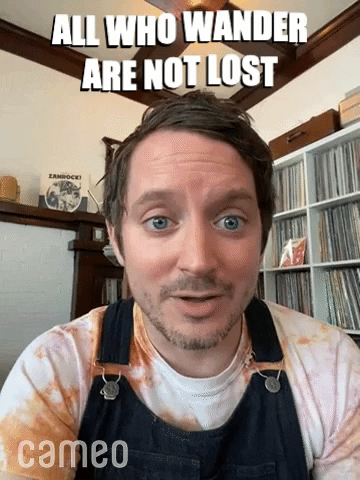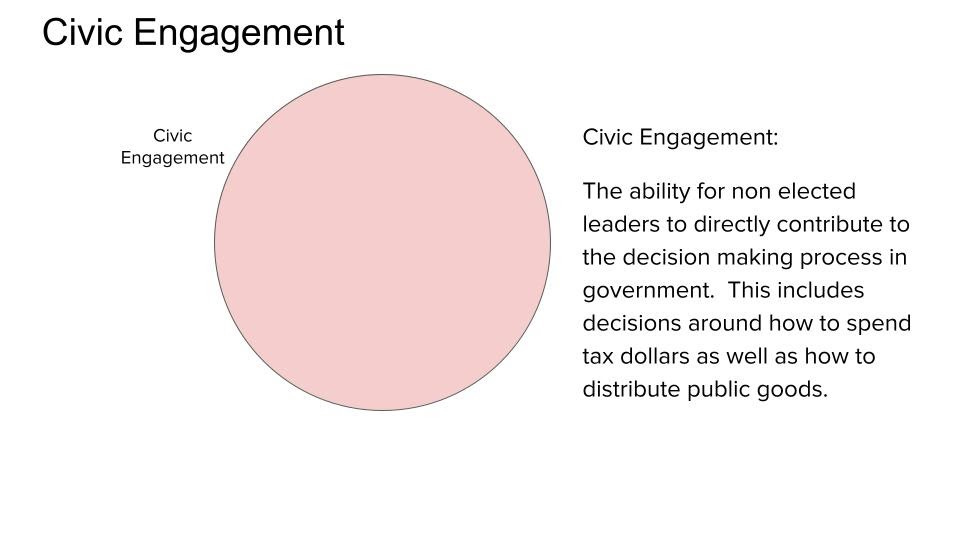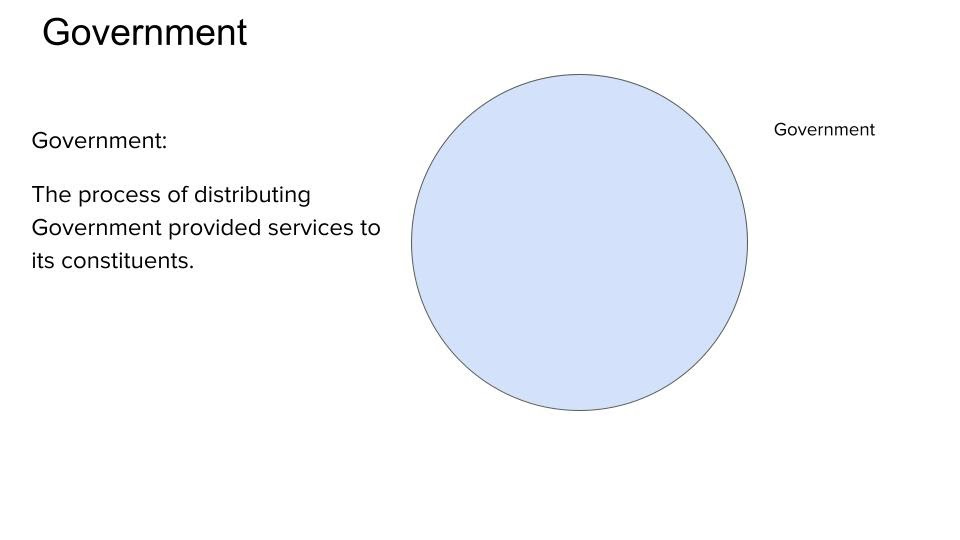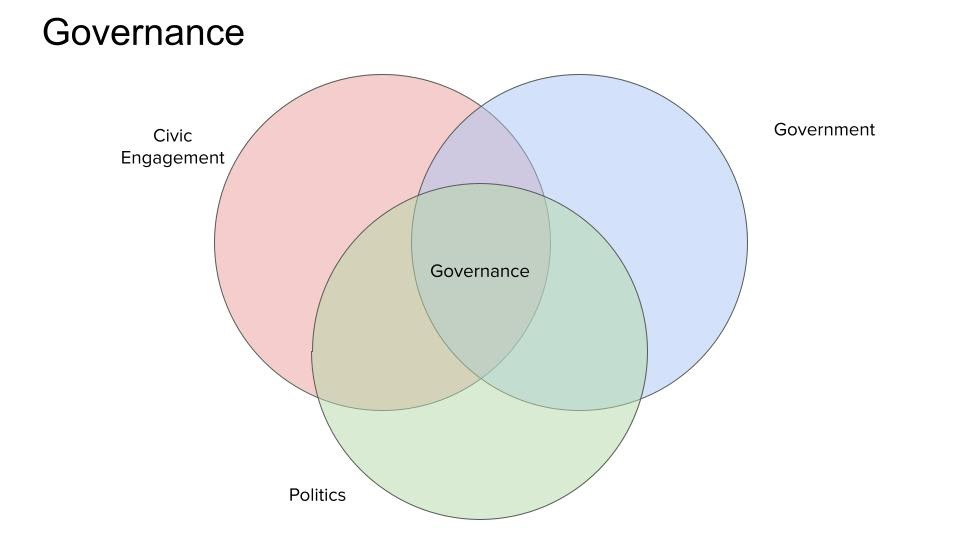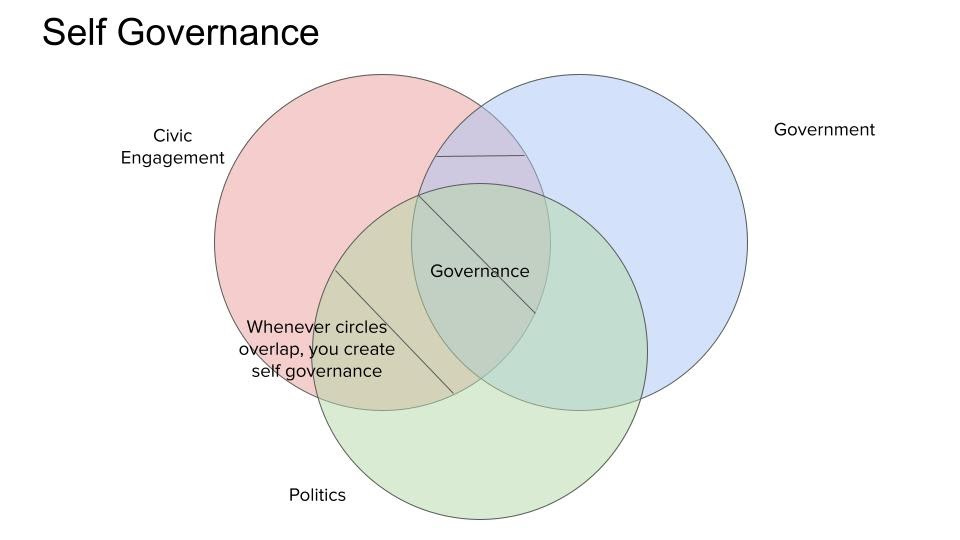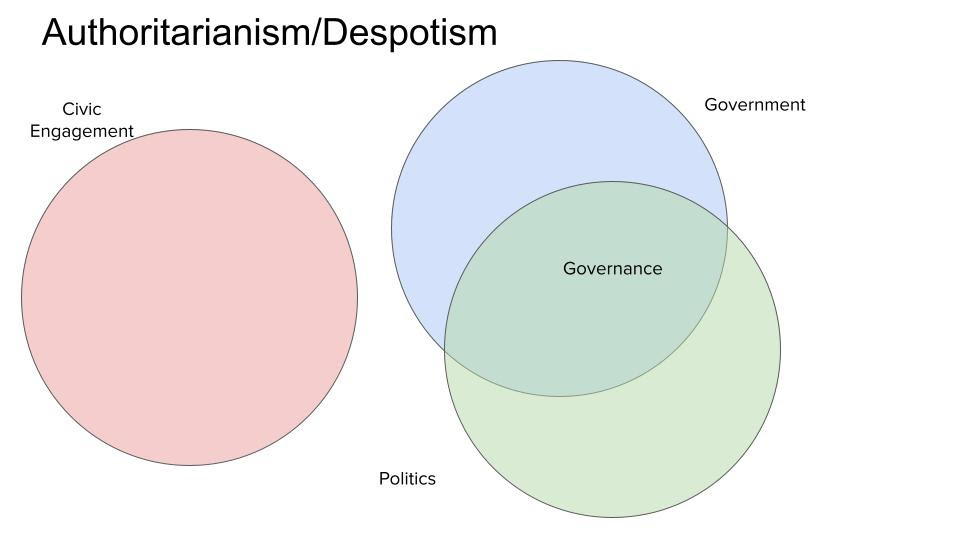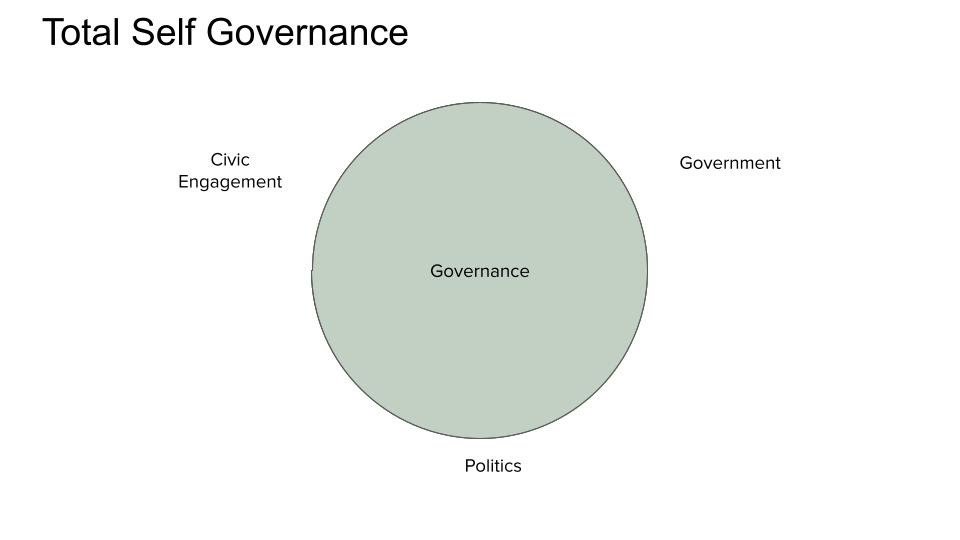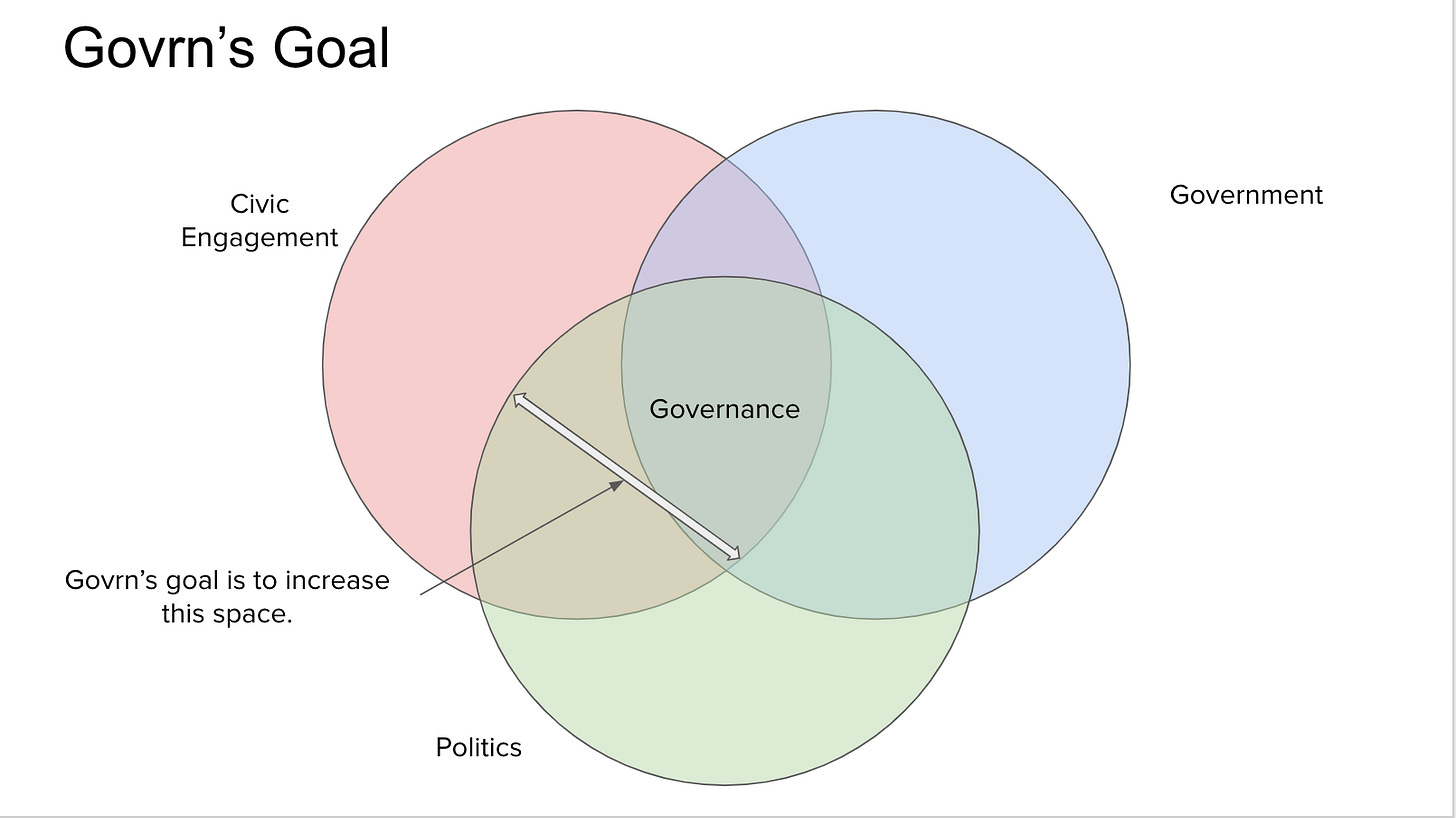How Govrn thinks about Governance
"Because it's the governance we deserve, but not the one we need right now." - Commissioner Governance
It feels like we’re using the word “Governance” more but understand less of what it actually means. At best, most definitions use the word in the definition (i.e., Governance is the act of governing).
This is a problem. How can we use new governance solutions to “redistribute power to the people” if we can’t even define the word?
I have a confession, I was (am) one of those people that carelessly use it all the time. This worked… until it didn’t and I was caught in the act. One day, as I was on one of my “way too long-winded” soapbox speeches, a friend stopped me mid-sentence and asked me, “Aaron, what the hell is governance?”
So I started down a journey to answer this question. I had just started a PoliticalTech startup, was a RadicalxChange Fellow, was researching different types of city governments, categorizing new digital and crypto networks, and discovering Open Source Software governance. This was something I needed to know.
“I needed to create this framework for myself, but I hope it provides you a starting point for your journey as well.”
What did I find? That everyone had this same question. It felt as though more people were asking this question than trying to answer it. So I decided to try and answer it.
This article outlines the framework I’ve adopted to:
Understand governance
Define how it’s related to politics, civic engagement, and government
Categorize how Govrn fits in the eco-system
My goal is to publish three articles on this topic. This article, being the first one, defines governance for local nation-state government (this is where I started my journey). The second article dives into how this applies to next-generation digital and token communities (and why you NEED to care if this topic is important to you). And finally, we’ll switch the lens from thinking about the “components” of governance to the “processes” that make it up.
I’m writing this in hopes that someone else critiques it. As I said, this is a journey, and my guess is that there is more wrong than right in this framework. I needed to create this framework for myself, but I hope it provides you a starting point for your journey as well.
Let’s Start with the Answer
I'm going to start with the answer to the question, “What is Governance?” Afterward, I’ll break down and explain each component.
So what is Governance? Governance is the confluence and interaction of three different spheres, (1) Civic Engagement, (2) Politics, and (3) Government.
Specifically, Governance is the checks and balances that the people in each circle have on another circle. Another way to think about it is the power distribution between anyone that interacts in a decision-making process.
An example of this in local politics could be the decision-making process of how the "state" collects funds and spends those funds. A Mayor proposes a budget, which must be reviewed and approved by a committee, which is required to hold an open town hall for constituent feedback. Then it would need to be approved by the government department that manages the budget.
That process of checks and balances is what we refer to as governance.
Now let's break down each component.
The Components of Governance
First, we have the Civic Engagement circle.
Civic Engagement (or civics) is the ability or process for non-elected leaders to directly contribute to the decision-making process in government. Examples of civic engagement are voting on referendums, protests, or participating in town halls.
Next, we come to Politics.
Politics is the debate and struggle to obtain a higher amount of influence with the goal of providing value to the constituents who elected you. Examples of politics are voting on legislation, leading committees, proposing policies, or running for office.
Last but not least, we come to Government.
Government is the process of collecting and distributing Government provided services to its citizens. Examples include decisions on how best to allocate food stamps, collect taxes, or fund schools.
Governance is the Interaction Point
The place where all three of these circles interact is what we refer to as Governance. It's the specific set of rules (or protocol) used to determine how each circle interacts and provides a check/balance on the other circles.
Further, anywhere that the Civic Engagement circle overlaps with either Politics or Government, we refer to as "Self Governance.” This is because it shows citizens involved in, contributing to, or controlling services that the state would otherwise own.
Governance in the World 🌎
Now, let’s run through a couple of Governance structures to see if this framework holds up.
Authoritarianism/Despotism
Authoritarianism/Despotism is when the state has absolute control over how the government is run. Said another way, it's when civics or citizens have no way to give input to the governance process. We can imagine that the circles would look like this.
Direct Democracy
A Direct Democracy is when its citizens vote on every initiative. In other words, it allows all citizens to be politicians. We imagine the circles might look like this.
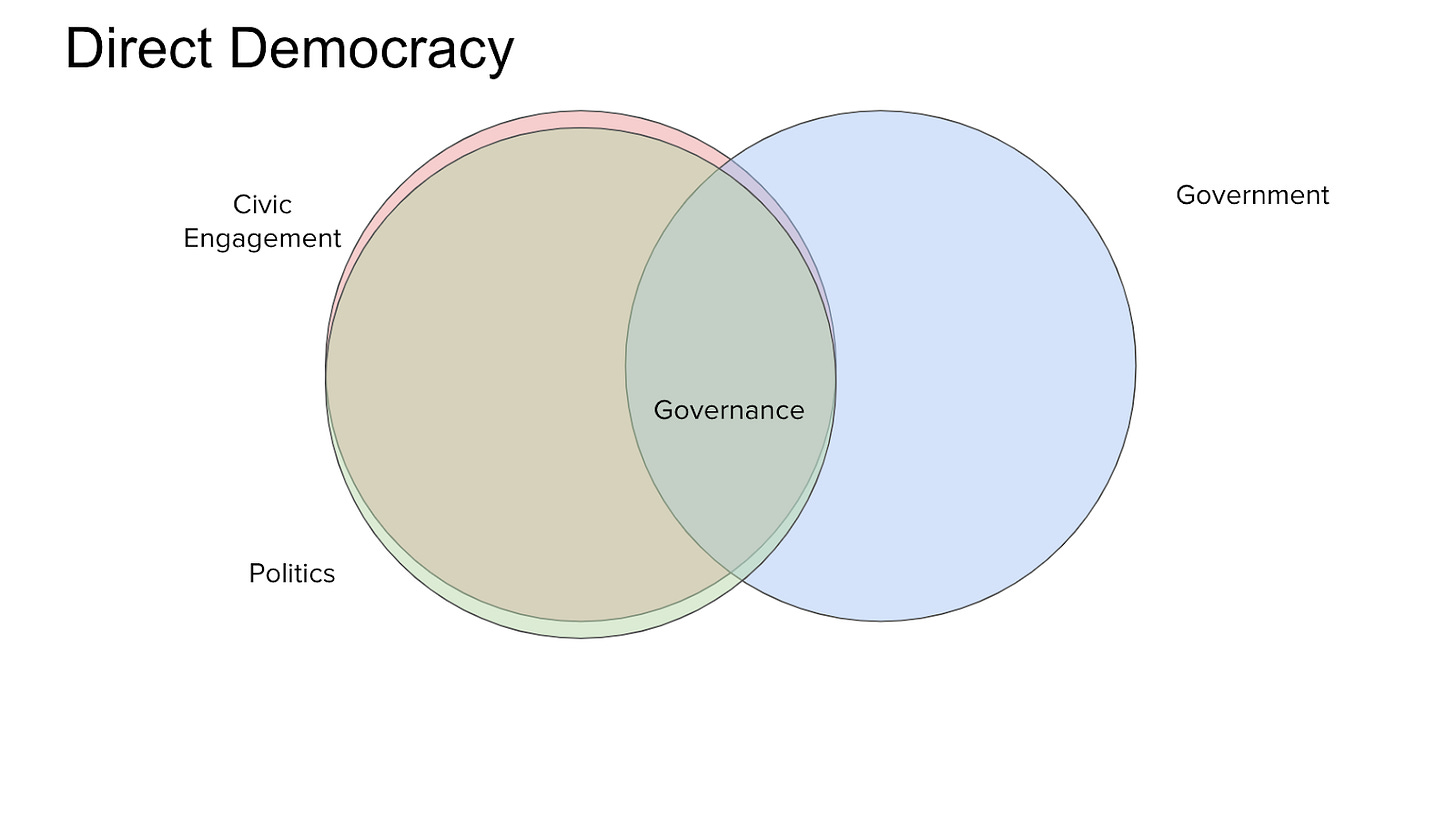
Total Self Government
This is when all citizens are in charge of voting on initiatives, politicking, and delivering/extracting the value from the public goods. We might imagine the circles would look like this.
A note - we know that you could have different government systems with a similar intersection of circles. For example, Communism and Democracy are very different systems but might have similar overlapping circles. The way you can differentiate these two ideas is how they each manifest in the "processes" of governance (what we will dive into in article 3).
I want to stress that we designed this framework to help you analyze a system of governance, but alone it is not enough to fully define or classify the system of governance.
Understanding the Levers
Now that we understand how these different actors can interact, let’s look at how we can leverage this framework when designing governance solutions.
Think of startups, solutions, or processes as levers that can increase or decrease the overlapping areas of the circles. For this discussion, I will focus on how we can increase “The Self Governance Zones."
“Self Governance requires solutions to “govern with” the constituents.”
Going back to my earlier point, "self-governance" is where citizens can have more control over governance. That means that there are three Self-Governance Zones we can increase or decrease. We can:
Give citizens additional abilities to access government-provided services and funds (this would include citizens creating their own public goods using government-provided funding).
Give citizens additional abilities to vote on legislation.
Give citizens additional abilities to influence politicians or politics.
Again, note this only provides a framework to understand the lever or zone a solution is interacting with. There are many different actual solutions someone implements to use one of these levers. For example, two ways we could give citizens additional abilities to influence politics are:
Making it easier for citizens to organize and lobby politicians
Build better and cheaper polling so constituents can more easily give feedback to politicians.
In both these ways, we're giving citizens additional abilities to influence politics, but the solution used is very different.
Mapping out the Landscape
I want to give you an example of how a solution or company might fit into this landscape. At Govrn, we're building a campaign finance platform that enables constituents to make Outcome-Based Donations (OBDs) to political campaigns. OBDs are crowdfunded donations held in escrow until predefined community metrics are reached (imagine a mashup between Kickstarter and OKRs).
OBDs specifically use campaign finance to enable constituents to have another tool to influence politics. At a much higher level, Govrn’s goal is to always be increasing the overlap in circles between Civics and Politics.
Another example of a company that operates in the space is Code for Democracy. Code for Democracy allows anyone to view how money flows in campaign finance so you can better understand the incentives at play.
Now compare this to co:census. Co:census provides better public engagement services for government officials so that government can uncover new and more equitable ways to distribute public goods (like public transit). They work in the space of overlapping the circles of civics and government.
“If we don't take time to understand what power dynamic is changing with each new idea, then we are at risk of repeating the mistakes of previous generations.”
Note: For the circles to overlap more, it requires that there be a collaboration or increase of participation between the two circles.
An example once more - co:census brings more people together in the decision-making process. Co:census’ platform is grounded in their evidence-based methodology: data by the people, for the people. This is different than tools that purely measure and run analysis on constituents without their active participation.
An example of this is if a politician runs analytics on Facebook posts to understand or categorize constituents rather than running a town hall meeting. In our mind, the “Facebook Analytics” type of solutions do not actually increase the overlap of the circles, as it does not increase participation.
This isn’t inherently bad, just different. Does the running of analytics help the politician understand the constituent better? Yes. But it accomplishes it by “the governing of” a constituent, not “the governing with” a constituent.
Self Governance requires solutions to “govern with” the constituents.
Take time to understand the Power Dynamics
At Govrn, this is the framework we use when someone speaks to us about "Governance,” or any of the components under governance (civics, politics, and government). It's not supposed to define the governance system used, but rather provide a framework to understand how a given mechanism or idea shifts the power dynamics in a governance structure.
This last point is vital. We are starting to go through a governance renaissance, with insane amounts of study and innovation being done on the topic.
If we don't take time to understand what power dynamic is changing with each new idea, then we are at risk of repeating the mistakes of previous generations.
That said, we need more innovation, and we need more people experimenting in this space. So I ask, next time you want to try a new idea that "returns power to the people,” check which lever you are pulling to ensure it accomplishes your intended goal.
Part 2 of this series will come out soon. If you want to be notified or receive it in your inbox, subscribe to our Community Publication, Govrnance, where we publish interesting thought pieces (like this one). Hit that “Subscribe” button below.
A special shout and thanks out to Tiasia O'Brien, Kathy Qian, and Christine Vandevoorde for contributing and editing this paper. And thanks to all those who have provided informal feedback on these concepts over the past six months.
Three Asks:
Have an idea or experiment? We'd love to hear about it. We have a Govrn Community Discord where we talk non-stop about these topics.
Know others that’d be interested in Govrnance? Please share our substack with others! The more eyes we get on this paper, the more confident we are in our ideas.
What’d we get wrong? We want to know so we can fix and improve our ideas. Comment below letting us know your thoughts.



